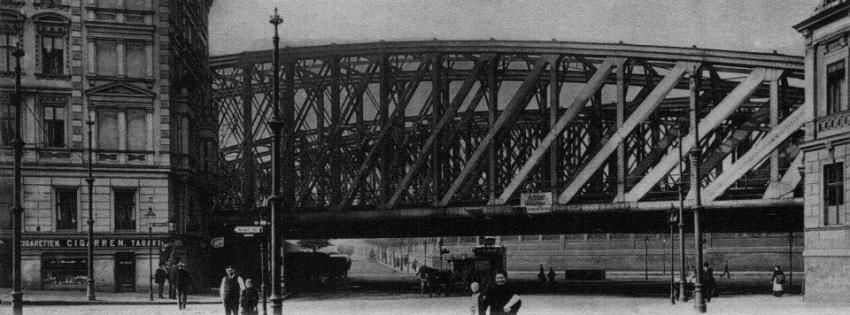LIESENBRÜCKEN
Acker-, Schering-, Liesen and Gartenstraße form a star intersection with a roundabout. Its level was artificially lowed to accommodate four impressive Liesenbrücken rail bridges, an outstanding engineering facility of the late XlXth century, which rose among the construction of the Berlin-Stettin railway.
Bridges were built between 1890 and 1896 by the architects B.Hildebrandt and K. Bathmann, to relieve traffic across the complex intersection by splitting it into levels. Three single-track framework bridges with lengths between 64 and 82 meters were built from 1890 to 1892. A large 94-meter double-track bridge was built east of them in 1896. During the construction the rails were temporarily carried out on bulk dams. Bridges represented metal frameworks, whose sections were balanced by semi-parabolic upper constrictions ending with portals. The railway tracks were laid over the plates covered with law gravel embankments. Today the plates are not present, so the first step of any recovery process would be to make there some kind of floor. The western single-track framework bridge served as a shuttle line for the locomotives, going to a repair depot at the Berlin-Gesundbrunnen station. Double-track eastern bridge carried the rails of the Northern railway to Stettin. From 1934 to 1939 recently constructed North-Southern branch of S-Bahn proceeded through these bridges as well towards Gesundbrunnen. In 1956-57 during the update of both western bridges, framework was replaced with steel carriers. The coverings and lateral wings of the bridges were completely dismantled for this purpose and later restored again. In the meanwhile S-Bahn traffic was launched over the trunk routes of the eastern bridge decommissioned in 1952. Today the repaired western bridges are used only. Eastern bridges are threatened by a fate of the bridges on Yorckstr., which were unwelded, because DB couldn't find any application for them anymore and decided to save money from their maintenance.
Liesenbrücken bridges are graceful and imposing. Functionality of steel modules meets an effective architectural design. The upper constrictions are bent by an elegant semi-parabola. Vertical piles are crossing the diagonal ones gradually narrowed from the bridge ends to its center and there crossed with the counter diagonal piles inclined in the opposite side. The intricate web of thin lateral constrictions symphonize with massive upper steel beams. Even after replacement of the two western single-track bridges with simple platforms leaned on simple piles in 1956-57, the remaining bridge modules kept a mighty monumental look, inspiring feeling of power and dynamics. The framework carriers, towering up to a five-floor building height, which are effectively looking from nearby streets, are an expression of sophisticated engineering art of Germany of the Wilhelm's the II eras. Liesenbrücken were surely a demonstration of might of the Prussian Railway. Today the tracks of the old bridge modules are dismantled. S-Bahn uses only the new strip.
The Berlin Wall passed directly under the bridge.


